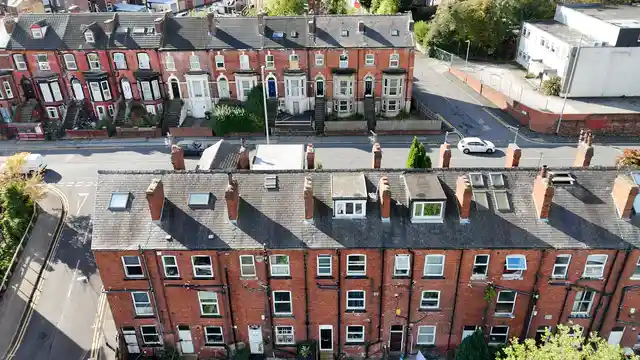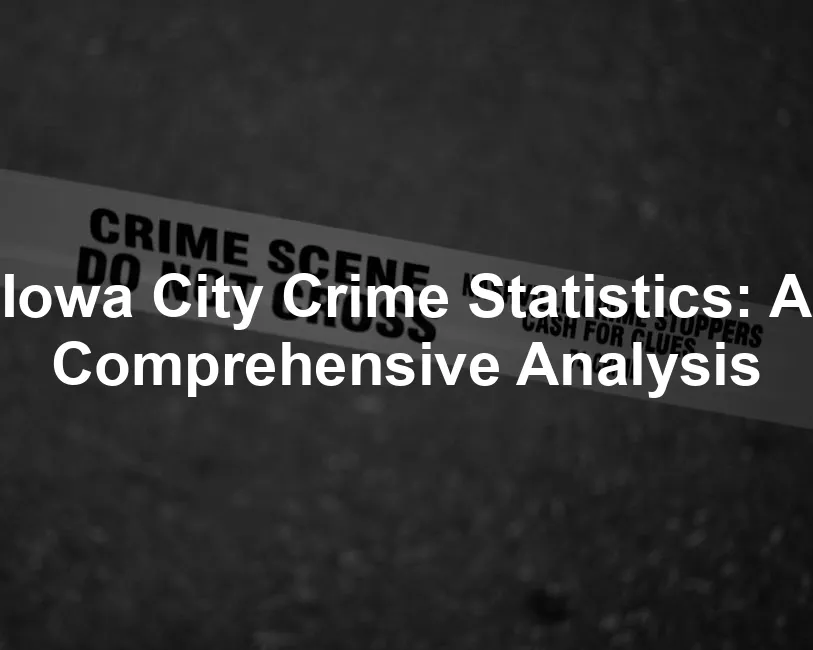Introduction
Nestled in the heart of Iowa, Iowa City is a vibrant hub renowned for its rich cultural scene and educational institutions, including the prestigious University of Iowa. With a population that thrives on diversity and creativity, Iowa City stands out as a welcoming community. However, like any urban area, it grapples with crime, making understanding its crime statistics all the more crucial.
Why should you care about crime rates? Well, whether you’re a long-time resident, a prospective mover, or a policymaker, these statistics hold significant weight. They help residents assess safety, guide prospective movers in their decision-making, and inform policymakers on where to allocate resources.
Iowa City’s crime trends reveal an intriguing narrative. While crime exists, it’s essential to look at how Iowa City stacks up against national averages. The overall trend indicates that Iowa City enjoys a relatively lower rate of violent crime compared to the national benchmark. In fact, the current violent crime rate sits at 18.8 incidents per 100,000 residents, whereas the national average is 22.7. Property crime, on the other hand, is just slightly above the national average, with a rate of 35.8 compared to 35.4 nationally. So, while crime isn’t absent, it seems Iowa City manages to keep things relatively in check.

Speaking of safety, have you ever thought about being prepared for unexpected situations? A Home Security Camera System can provide peace of mind by allowing you to monitor your home while you’re away. It’s a small investment for your safety that can make a big difference!
Understanding Iowa City Crime Statistics
The Crime Overview
When assessing crime, it’s vital to differentiate between violent and property crimes. Violent crimes include offenses like murder, assault, and robbery—acts that threaten personal safety. Property crimes, which encompass burglary and theft, focus more on the invasion of personal space and possessions.
In Iowa City, the statistics paint a telling picture. The violent crime rate stands at 18.8, significantly lower than the national average of 22.7. This means residents have a better chance of feeling safe from violent acts compared to many other cities across the United States.
On the property crime front, the current rate is 35.8. While this is slightly higher than the national average of 35.4, it’s crucial to note that property crime rates can fluctuate based on various factors, including economic conditions and law enforcement efficacy.

But hey, while we’re on the topic of safety, how about a Smart Door Lock? It’s like giving your door a brain! With features like remote access and keyless entry, it’s a high-tech way to keep your home safe and sound.
Crime Ranking and Safety Grades
How does Iowa City fare in terms of crime ranking? Within the state of Iowa, Iowa City is frequently regarded as a safer option compared to larger urban areas. It often receives safety grades that reflect a mixed but generally favorable perception from residents. According to a recent community poll, a notable 78% of respondents felt pretty safe in their surroundings, while only 2% expressed significant safety concerns.
In the grand scheme of things, understanding these rankings and safety grades can help residents and potential movers gauge whether Iowa City aligns with their personal safety expectations. The data suggests that while Iowa City isn’t devoid of crime, it is relatively safe, offering a community where individuals can live, work, and play without constant fear.
In summary, Iowa City presents a unique case where the crime statistics, when analyzed closely, indicate a community striving for safety while facing common urban challenges. Understanding these trends can empower residents and officials alike to foster an even safer environment.

And let’s not forget about personal safety gadgets! A Personal Alarm Keychain can be a lifesaver in emergencies. It’s small, discreet, and can emit a loud sound to deter potential threats. Safety in style!
Detailed Crime Categories
Violent Crimes
Definition and Types
Violent crimes are serious offenses that involve the use or threat of force against individuals. They leave deep scars in communities, creating fear and uncertainty. In Iowa City, these crimes are categorized into four main types:
- Murder: This is the unlawful killing of another person. It is the most serious violent crime, and Iowa City strives to keep these incidents low.
- Rape: A heinous act that violates personal safety and trust. Iowa City is working to support survivors and reduce occurrences through community programs.
- Robbery: Unlike theft, robbery involves taking property directly from a person through force or intimidation. It’s a crime that understandably frightens residents.
- Assault: This includes physical attacks or threats of harm. It’s a broader category that covers everything from minor scuffles to serious injuries.
Each of these crimes affects the fabric of community life, making prevention and awareness essential.

And when it comes to being prepared, a LED Flashlight for Emergency Use is a must-have! Whether there’s a power outage or a late-night adventure, you’ll be glad to have a reliable light source at hand.
Statistical Analysis
The statistics for violent crimes in Iowa City reveal important trends. The violent crime rate is currently 18.8 per 100,000 residents, which is notably lower than the national average of 22.7. This positive trend indicates that the community is becoming safer over the years.
Year-over-year data shows fluctuations in specific crimes. For instance, murder rates have remained low, with only 1.3 incidents reported recently. Rape incidents are at 24.1, significantly below the national average of 40.7. Robberies are also quite low, with a rate of 38.8 compared to the national average of 135.5, reflecting effective local law enforcement strategies.
Assault, while more prevalent, still sits below national benchmarks with a rate of 282.7, against a national average of 199.3. Overall, these numbers paint a picture of a community that is working hard to combat violent crime effectively.

Property Crimes
Definition and Types
Property crimes involve the unlawful taking or destruction of someone else’s property. They are often viewed as less severe than violent crimes, but they can disrupt lives just as significantly. In Iowa City, property crimes are categorized into three main types:
- Burglary: This involves illegally entering a building with the intent to commit a crime, usually theft. It leaves victims feeling violated and insecure in their homes.
- Larceny: This is the theft of personal property without breaking and entering. It can range from shoplifting to stealing bicycles, affecting community trust.
- Auto Theft: The unlawful taking of a vehicle. It’s a crime that hits individuals hard, both financially and emotionally.
Understanding these categories helps residents take preventive measures.

Speaking of preventive measures, how about investing in a Home Safe for Valuables? Protect your important documents and cherished items from theft or damage. It’s peace of mind you can lock up!
Statistical Overview
The property crime rate in Iowa City is currently 35.8 per 100,000 residents, which is slightly above the national average of 35.4. The statistics indicate that while property crimes are present, they are being addressed effectively by local law enforcement.
Burglary rates are particularly noteworthy. They sit at 231.4, significantly lower than the national average of 500.1. This suggests that Iowa City is implementing successful preventative measures. Larceny rates are reported at 1,361.9, which is still below the national average of 2,042.8, indicating a positive trend.
Auto theft is another area where Iowa City shows a commitment to improvement. The rate of 181.9 is lower than the national average of 284, reflecting the community’s vigilance in crime prevention.
By analyzing these statistics, it becomes clear that while Iowa City faces challenges with property crimes, ongoing local efforts and community involvement are crucial in maintaining safety and security.

Iowa City Crime Trends Over the Years
Historical Crime Rates
Iowa City has experienced a rollercoaster of crime rates since 2000. Let’s break it down. Over the past two decades, both violent and property crimes have seen significant fluctuations. In 2000, the violent crime rate was a staggering 513.5 per 100,000 residents. Fast forward to 2022, and that number has plummeted to 18.8, which is quite the drop! This dramatic decline can be attributed to a mix of community initiatives, enhanced policing strategies, and perhaps a sprinkle of good luck.
Property crimes, on the other hand, have fluctuated less dramatically. Starting at 2,746.6 in 2000, the rate now sits at 35.8. While it’s slightly above the national average, it’s important to recognize that many factors contribute to these numbers. The economic climate, community engagement, and local policies all play a role.
Now, let’s look at some notable spikes. The years 2002 and 2003 saw a sharp increase in violent crime, mainly due to a rise in aggravated assaults. The community’s response? Awareness campaigns and increased police presence in high-risk areas.
Conversely, from 2010 onwards, there’s been a clear downward trend in violent crime rates. A significant factor? The establishment of community policing programs that fostered better relationships between law enforcement and residents, transforming Iowa City into a safer place.

Year-over-Year Comparisons
When we take a closer look at the year-over-year comparisons, a clear narrative emerges. A chart detailing crime rates from 2000 to 2022 reveals a consistent decline in violent crimes. The most recent statistics show that violent crime rates have decreased by 17.2% from the previous year, while property crimes saw a slight increase of 6.2%.
What does this mean for residents? Well, it implies that while violent crime is becoming less of a concern, the uptick in property crimes warrants attention. Local law enforcement must adapt strategies to address this trend, perhaps by enhancing neighborhood watch programs or increasing patrols in affected areas.
The implications of these trends are twofold. On one hand, residents can enjoy a more secure living environment, which positively impacts property values and community pride. On the other hand, the slight rise in property crimes reminds us that vigilance is key.
In summary, Iowa City’s crime trends over the years paint a picture of a community striving for safety. While it has made great strides in reducing violent crime, an ongoing commitment to addressing property crimes will be crucial in maintaining the overall sense of security that residents cherish. As they say, safety doesn’t just happen; it’s built together.

And if you’re looking to enhance your safety further, consider equipping your home with Home Surveillance System with Night Vision. It’s like having an extra pair of eyes watching over your property, day and night!
Community Safety and Perception
Local Resident Sentiment
Safety is a big deal in Iowa City. A recent survey revealed that 78% of residents feel pretty safe in their neighborhood. That’s a reassuring statistic! Only about 2% expressed significant safety concerns. So, what gives?
The Iowa City Police Department has been proactive in community engagement and outreach. In another survey, 70% of respondents reported that they found law enforcement to be visible and responsive. This is vital. When residents see police officers in their area, it creates a sense of security.
However, not everyone shares this sentiment. About 22% of residents noted that while police presence is visible, response times can be a tad slow during high-demand situations. It seems that there’s always room for improvement, even in a community that’s largely satisfied.
Despite the minor concerns, the overall sentiment suggests that Iowa City is a place where residents can walk with a degree of confidence. It’s essential to recognize that perceptions of safety can heavily influence community dynamics. When people feel secure, they engage more—whether it’s attending local events or simply enjoying a stroll at night.

And speaking of feeling secure, investing in a Emergency Whistle for Safety can be a smart choice! It’s compact, easy to carry, and can alert others in case of an emergency. Safety first, right?
Comparison with Nearby Cities
When we stack Iowa City against its neighbors—Coralville, North Liberty, and West Branch—an interesting picture emerges. Here’s a quick comparison based on recent crime data.
- Coralville, IA: Violent crime rate sits at 313.1, with property crime skyrocketing to 3,126.8. Yikes! That’s notably higher than Iowa City.
- North Liberty, IA: The violent crime rate is 348.5, while property crime is 602.4. Not exactly a walk in the park, either!
- West Branch, IA: Holding its own, West Branch has a violent crime rate of 211.4 and property crime at 211.4 as well.
So, what do these comparisons tell us? Iowa City, with a violent crime rate of 18.8, is markedly safer than its neighboring cities. Even its property crime rate of 35.8 is more manageable compared to Coralville and North Liberty.
Iowa City’s lower crime statistics can be attributed to active community policing strategies and resident involvement in crime prevention efforts. This data paints a clear picture: while crime exists, it’s well below that of its nearby counterparts. This gives Iowa City a reputation as a relatively safe place, making it attractive to families and individuals looking to settle down.
In conclusion, the community sentiment in Iowa City leans toward safety, bolstered by effective policing. When compared to nearby cities, Iowa City emerges as a safer option, showcasing the positive impact of community engagement and law enforcement efforts on public safety perceptions. Residents can take pride in their city, knowing they’re part of a community that cares about safety and well-being.

Factors Impacting Crime Rates in Iowa City
Socioeconomic Factors
Crime thrives in shadows, and socioeconomic conditions are the light—or lack thereof—that can either illuminate or obscure these shadows. In Iowa City, the poverty rate stands at 27.3%, significantly higher than the national average of 15.1%. This stark contrast can correlate with higher crime rates.
Education also plays a pivotal role. About 93.1% of residents have completed high school, surpassing the national average of 83%. Higher education levels generally correlate with lower crime rates. When people have access to education, they often have better job opportunities, leading to reduced poverty levels and, consequently, lower crime rates.
Rental rates in Iowa City are slightly above the national average, with an average rent of $976. Higher rental costs can strain finances, particularly for lower-income families. This financial pressure can lead to increased property crimes as individuals seek ways to cope with economic hardships.
In summary, the socioeconomic landscape in Iowa City significantly influences crime rates. High poverty levels, while offset by educational attainment, create a complex interplay that law enforcement and community programs need to address. Understanding this relationship is crucial for developing effective crime prevention strategies. By focusing on education and economic development, the community can work towards a safer Iowa City for everyone.

And while we’re discussing safety, consider the importance of emergency preparedness. An Emergency Preparedness Kit can ensure you’re ready for any unexpected situations. It’s like having a safety net right at home!
Law Enforcement and Community Programs
The Iowa City Police Department (ICPD) plays a pivotal role in ensuring public safety. With a philosophy centered on community engagement, the ICPD emphasizes proactive crime prevention. Officers engage with residents, fostering trust and open communication. This strategy not only helps in crime deterrence but also creates a safer environment for everyone.
The department employs various initiatives aimed at reducing crime rates. One notable program is the Neighborhood Watch, where residents collaborate with law enforcement to monitor suspicious activities. This partnership promotes vigilance and empowers citizens to take an active role in their community’s safety.
Additionally, the ICPD hosts community events, such as safety fairs and educational workshops. These gatherings provide valuable information on crime prevention strategies, helping residents protect their homes and loved ones. From personal safety tips to advice on securing property, these programs equip citizens with the knowledge they need to stay safe.
Moreover, the department utilizes social media to keep the community informed. Regular updates on crime trends and safety tips are shared, ensuring residents are aware of any potential threats. This transparency builds trust and fosters a collaborative spirit between the police and the community.
In summary, the Iowa City Police Department’s approach to crime prevention hinges on community involvement. Through various programs and initiatives, they aim to create a safer environment for all residents. By working together, law enforcement and the community can effectively reduce crime and enhance public safety.

Conclusion
Understanding crime statistics is essential for residents, potential movers, and policymakers in Iowa City. The analysis of crime trends reveals a community that is generally safe, with a lower violent crime rate compared to the national average. The current violent crime rate stands at 18.8 incidents per 100,000 residents, while property crime is slightly above the national average at 35.8.
These statistics highlight the importance of awareness and community engagement in maintaining safety. Residents can take comfort in knowing that local law enforcement actively works to prevent crime and foster a secure environment. However, it is equally important for individuals to remain vigilant and informed about their surroundings.
Community programs, such as the Neighborhood Watch, play a crucial role in enhancing safety. By participating in these initiatives, residents can contribute to crime reduction efforts. This sense of collective responsibility not only strengthens neighborhoods but also builds a supportive community spirit.
Moreover, understanding crime statistics aids in informed decision-making. For potential movers, it’s vital to assess safety levels when considering a new home. Policymakers rely on this data to allocate resources effectively and develop strategies that address safety concerns.
In conclusion, Iowa City’s crime statistics paint a picture of a community striving for safety while facing common urban challenges. While the overall crime rate may be lower than the national average, ongoing community engagement remains critical. Together, residents and law enforcement can work towards a safer and more vibrant Iowa City, ensuring that everyone can enjoy the unique charm it has to offer.

For a comprehensive analysis of crime statistics, you can explore Fremont Crime Statistics.
Please let us know what you think about our content by leaving a comment down below!
Thank you for reading till here 🙂
All images from Pexels




